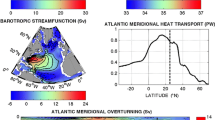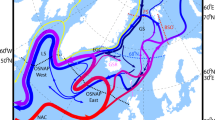Abstract
We use a coarse resolution ocean general circulation model to study the relation between meridional pressure and density gradients in the Southern Ocean and North Atlantic and the Atlantic meridional overturning circulation. In several experiments, we artificially modify the meridional density gradients by applying different magnitudes of the Gent–McWilliams isopycnal eddy diffusion coefficients in the Southern Ocean and in the North Atlantic and investigate the response of the simulated Atlantic meridional overturning to such changes. The simulations are carried out close to the limit of no diapycnal mixing, with a very small explicit vertical diffusivity and a tracer advection scheme with very low implicit diffusivities. Our results reveal that changes in eddy diffusivities in the North Atlantic affect the maximum of the Atlantic meridional overturning, but not the outflow of North Atlantic Deep Water into the Southern Ocean. In contrast, changes in eddy diffusivities in the Southern Ocean affect both the South Atlantic outflow of North Atlantic Deep Water and the maximum of the Atlantic meridional overturning. Results from these experiments are used to investigate the relation between meridional pressure gradients and the components of the Atlantic meridional overturning. Pressure gradients and overturning are found to be linearly related. We show that, in our simulations, zonally averaged deep pressure gradients are very weak between 20°S and about 30°N and that between 30°N and 60°N the zonally averaged pressure grows approximately linearly with latitude. This pressure difference balances a westward geostrophic flow at 30–40°N that feeds the southbound deep Atlantic western boundary current. We extend our analysis to a large variety of experiments in which surface freshwater forcing, vertical mixing and winds are modified. In all experiments, the pycnocline depth, assumed to be the relevant vertical scale for the northward volume transport in the Atlantic, is found to be approximately constant, at least within the coarse vertical resolution of the model. The model behaviour hence cannot directly be related to conceptual models in which changes in the pycnocline depth determine the strength of Atlantic meridional flow, and seems conceptually closer to Stommel’s box model. In all our simulations, the Atlantic overturning seems to be mainly driven by Southern Ocean westerlies. However, the actual strength of the Atlantic meridional overturning is not determined solely by the Southern Ocean wind stress but as well by the density/pressure gradients created between the deep water formation regions in the North Atlantic and the inflow/outflow region in the South Atlantic.

















Similar content being viewed by others
References
Berliand M, Berliand T (1952) Measurements of the effective radiation of the earth with varying cloud amounts. Izv Akad Nauk SSR, Ser Geofiz, p 1
Böning C, Holland W, Bryan F, Danabasoglu G, McWilliams J (1995) An overlooked problem in model simulations of the thermohaline circulation and heat transport in the Atlantic ocean. J Clim 8:515–523
DeBoer A, Nof D (2004) The Bering Strait’s grip on the northern hemisphere climate. Deep Sea Res 51:1347–1366
DeBoer A, Nof D (2005) The island wind-buoyancy connection. Tellus 57A:783–797
Fichefet T, Maqueda MM (1997) Sensitivity of a global sea ice model to the treatment of ice thermodynamics and dynamics. J Geophys Res 102:12609–12646
Gent P, McWilliams J (1990) Isopycnal mixing in ocean circulation models. J Phys Oceanogr 20:150–155
Gnanadesikan A (1999) A simple predictive model for the structure of the oceanic pycnocline. Science 283:2077–2079
Griffies S (1997) The Gent–McWilliams skew flux. J Phys Oceanogr 28:831–841
Hasumi H, Suginohara N (1999) Effects of locally enhanced vertical diffusivity over rough bathymetry on the world ocean circulation. J Geophys Res 104:23367–23374
Hofmann M, Morales-Maqueda M (2006) Performance of a second-order moments advection scheme in an ocean general circulation model. J Geophys Res (accepted)
Huang R (1999) Mixing and energetics of the oceanic thermohaline circulation. J Phys Oceanogr 29:727–746
Huck T, de Verdiere AC, Weaver A (1998) Interdecadal variability of the thermohaline circulation in box-ocean models forced by fixed surface fluxes. J Phys Oceanogr 29:865–892
Kalnay E, Kanamitsu M, Kistler R, Collings W, Deaven D, Gandin L, Iredell M, Saha S, White G, Woollen J, Zhu Y, Chelliah M, Ebisuzaki W, Higgins W, Janowiak J, Mo K, Ropelewski C, Wang J, Leetmaa W, Reynolds R, Jenne R, Joseph D (1996) The NCEP/NCAR 40-year reanalysis project. Bull Am Meteor Soc 77:437–471
Kamenkovich I, Sarachik E (2004) Mechanisms controlling the sensitivity of the Atlantic thermohaline circulation to the parameterization of eddy transports in ocean GCMs. J Phys Oceanogr 34:1628
Large W, Pond S (1981) Open ocean momentum flux measurements in moderate to strong winds. J Phys Oceanogr 11:324–336
Large W, Pond S (1982) Sensible and latent heat flux measurements over the ocean. J Phys Oceanogr 12:464–482
Lazar A, Madec G, Delecluse P (1999) The deep interior downwelling, the Veronis effect, and mesoscale tracer transport parameterizations in an OGCM. J Phys Oceanogr 29:2945–2961
Levermann A, Griesel A (2004) Solution of a model for the oceanic pycnocline depth: Scaling of overturning strength and meridional pressure difference. Geophys Res Lett 31
Levitus S (1982) Climatological atlas of the world ocean. NOAA Prof Pap 13:173
Lu Y, Stammer D (1998) Vorticity balance in coarse-resolution global ocean simulations. The ECCO Report Series 15
Lucarini V, Stone P (2005a) Thermohaline circulation stability: a box model study. part I: uncoupled model. J Clim 18:501–513
Lucarini V, Stone P (2005b) Thermohaline Circulation stability: a box model study. Part II: coupled atmosphere-ocean model. J Clim 18:514–529
Lucarini V, Calmanti S, Artale V (2005) Destabilization of the thermohaline circulation by transient changes in the hydrological cycle. Clim Dyn 24:253–262
Mignot J, Levermann A, Griesel A (2006) A decomposition of the Atlantic meridional overturning circulation into simple physical processes using its sensitivity to vertical mixing. J Phys Oceanogr (in press)
Munk W, Wunsch C (1998) Abyssal recipes II: energetics of tidal and wind mixing. Deep Sea Res 45:1977–2010
National Geophysical Data Center (1988) Data Announcement 88-MGG-02, Digital relief of the surface of the Earth, National Oceanic and Atmospheric administration (NOAA), Boulder
Nof D (2000) Does the wind control the import and export of the South Atlantic?. J Phys Oceanogr 30:2650–2667
Nof D (2003) The Southern Ocean’s grip on the northward meridional flow. Prog Oceanogr 56:223–247
Pacanowski R, Griffies S (1999) The MOM-3 manual. GFDL Ocean Group, NOAA/Geophysical Fluid Dynamics Laboratory, Princeton
Parkinson C, Washington W (1979) A large-scale numerical model of sea ice. J Geophys Res 84:311–337
Prather M (1986) Numerical advection by conservation of second-order moments. J Geophys Res 91:6671–6681
Rahmstorf S (1996) On the freshwater forcing and transport of the Atlantic thermohaline circulation. Clim Dyn 12:799–811
Rooth C (1982) Hydrology and ocean circulation. Prog Oceanogr 11:131–149
Shine K (1984) Parameterization of shortwave flux over high albedo surfaces as a function of cloud thickness and surface albedo. Q J R Meteorol Soc 110:747–764
Stommel H (1961) Thermohaline convection with two stable regimes of flow. Tellus 13:224–230
Stommel H, Arons A (1960) On the abyssal ciruclation of the world ocean—I. Stationary planetary flow patterns on a sphere. Deep Sea Res 6:151–173
Thorpe R, Gregory J, Johns T, Wood R, Mitchell J (2001) Mechanisms determining the Atlantic thermohaline circulation response to greenhouse gas forcing in a non-flux-adjusted coupled climate model. J Clim 14:3102–3116
Toggweiler J, Samuels B (1993a) Is the magnitude of the deep outflow from the Atlantic ocean actually governed by southern hemisphere winds? In: Heimann M (ed) Global carbon cycle, NATO ASI Series, Springer, Berlin Heidelberg New York, pp 333–366
Toggweiler J, Samuels B (1995) Effect of Drake passage on the global thermohaline circulation. Deep Sea Res 42:477–500
Toggweiler J, Samuels B (1998) On the ocean’s large-scale circulation near the limit of no vertical mixing. J Phys Oceanogr 28:1832–1852
Veronis G (1975) The role of models in tracer studies. Numerical models of ocean circulation. Natl Acad Sci 133–146
Wright D, Stocker T, Mercer D (1997) Closures used in zonally averaged ocean models. J Phys Oceanogr 28:791–804
Wunsch C, Ferrari R (2004) Vertical mixing, energy and the general circulation of the oceans. Annu Rev Fluid Mech 36:281–314
Yang J (2003) On the importance of resolving the western boundary layer in wind-driven ocean general circulation models. Ocean Modell 5:357–379
Zillmann J (1972) A study of some aspects of the radiation and the heat budgets of the southern hemisphere oceans. Meteor Stud 26:562. Bur. of Meteorology, Department of the Interior, Canberra
Acknowledgements
We are grateful to Marisa Montoya, Anders Levermann, Andrey Ganopolski, Stefan Rahmstorf, Matthias Hofmann, Till Kuhlbrodt, Eva Bauer and Juliette Mignot for useful discussions. The comments of 2 reviewers are greatly appreciated. A.G. was funded through the James S. McDonnell Foundation Centennial Fellowship.
Author information
Authors and Affiliations
Corresponding author
Rights and permissions
About this article
Cite this article
Griesel, A., Maqueda, M.A.M. The relation of meridional pressure gradients to North Atlantic deep water volume transport in an ocean general circulation model. Clim Dyn 26, 781–799 (2006). https://doi.org/10.1007/s00382-006-0122-z
Received:
Accepted:
Published:
Issue Date:
DOI: https://doi.org/10.1007/s00382-006-0122-z




